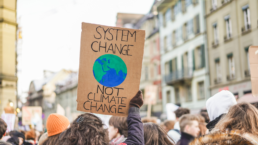The only way of ensuring that the overshoot is temporary is to decisively defeat the fossil fossil fuel cartel.
By Tom Athanasiou, The Nation
The 1.5°C temperature target is difficult to honestly and openly discuss. Within the climate movement, it has become a locus of anguish, confusion, and even despair. Long a symbol of mobilization and hope, 1.5° has become central to both activist campaigns and scientific analysis. Yet it’s now clear that the planet will almost certainly warm more than 1.5°C.

This is a rough prospect. It will likely condemn countless communities, many of them largely innocent of responsibility for the climate crisis, to suffering and destruction on a vast scale. It will trigger major ecological crises, extinctions first among them—the coral reefs, to pick just one example, could almost entirely vanish as the warming breaches the 1.5°C line.
These are not encouraging words, but they should not be taken as invitations to despair, or to a strange denialism in which, fearing hopelessness, we soft-pedal the severity of our circumstances. Because the truth is that the planet is not doomed, and neither are the world’s most climate vulnerable people.
The message here is that it’s time to act. Fortunately, significant action seems finally to be possible. At the last climate summit, after a grand push from the Global South coalition (the G77 + China) and the climate movement, the long-deadlocked battle to establish a “loss and damage” fund was finally won. That fund could finance disaster prevention and disaster mitigation in regions that have been pushed beyond their adaptive capacities. There will, of course, be limits to such interventions, but this could be the beginning of real climate internationalism. And it would not be alone. To cite just one other justification for cautious optimism, the renewable technology revolution has finally arrived.
Recent Posts
‘Unconstitutional. Unethical. Authoritarian.’ ICE Bars Millions Of Immigrants From Bond Hearings
July 18, 2025
Take Action Now One watchdog said the new policy “seems like a blatant attempt to stop them from exercising their right to due process.”……
Americans Are Not Nearly Alarmed Enough About Climate Change
July 18, 2025
Take Action Now Americans still don’t comprehend how imminent, dangerous, and far-reaching the threat is—and journalists are partly to blame.By…
The IRS Is Building A Vast System To Share Millions Of Taxpayers’ Data With ICE
July 17, 2025
Take Action Now ProPublica has obtained the blueprint for the Trump administration’s unprecedented plan to turn over IRS records to Homeland Security…
Israel’s Sudden Assault On Syria Is Unchecked Aggression
July 17, 2025
Take Action Now Jerusalem is bombing Damascus and threatening al-Sharaa’s rule, while Washington was hoping to help the nascent government on…




